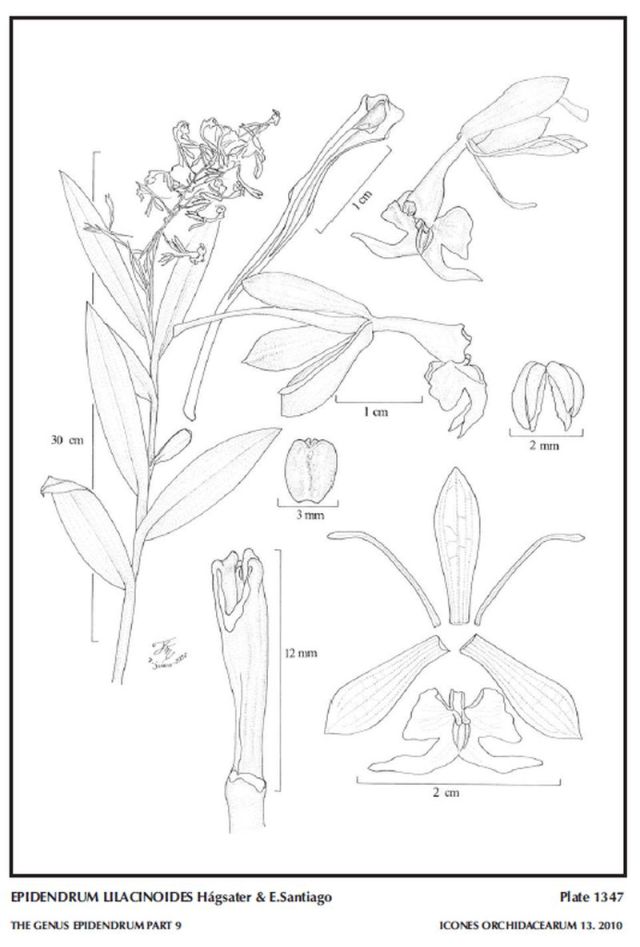

Epidendrum lilacinoides Hágsater & E.Santiago 2010 GROUP Pseudepidenrum SUBGROUP Porphyreum
TYPE Drawing by Jimenez and The AMO Herbaria Website





Common Name The Lilac Colored Epidendrum
Flower Size 1” [2.5 cm]
Found in Colombia and Venezuela at elevations of 2200 to 2600 meters as a medium to just large sized, cold growing epiphyte with simple, cane-like, terete, erect, straight stem carrying 13, all along the stems, alternate, articulate, subcoriaceous, evident veined, basal and apical leaves smaller than the middle ones, elliptic, acute to short acuminate, margin entire leaves that blooms in the winter and spring on a terminal, without a spathe, occuring only once, peduncle with 3 tubular, acute bracts, paniculate, 6 to 9 branched, each with a basal, narrowly triangular, acuminate bract, somewhat dense, simultaneously to 100 flowered inflorescence with much shorter than the ovary, narrowly triangular, acute, amplexicaul, progressively smaller towards the apex floral bracts and carrying resupinate, fragrant, purple flowers with a white lip that turns yellow with age.
"Epidendrum lilacinoides belongs to the GROUP Pseudepidenrum is characterized by caespitose plants, cane-like stems, acute to acuminate leaves, apical inflorescence, lacking a spathaceous bract, the petals filiform and the lip usually 3-lobed, with 3 parallel fleshy keels, the apical lobe often bifurcate, and the pollinia “bird-wing” type and SUBGROUP Porphyreum which has flowers colored reddish orange, deep purple or lilac-pink, the calli generally prominent, sometimes horn-like. The species is recognized by the purple flowers with a white lip, becoming yellowish with age, sepals oblanceolate-spatulate, .44 to .56" [11 to 14 mm] long, the lip with a pair of minute, globose calli, wider between the mid-lobe than the lateral lobes which are obliquely dolabriform. Epidendrum floribundum Kunth has somewhat smaller flowers, sepals .42" 10.5 mm long, green, petals and lip white, the basal lobes of the lip are semi-orbicular to subquadrate. Epidendrum angaritae Hágsater has greenish brown sepals the lip white spotted with purple, sepals are .6 to .68" [15 to 17 mm} long, the basal lobes of the lip dolabriform with the margin sinuous. Epidendrum macroceras Schltr. has smaller flowers, sepals .36" [9 mm] long, the apical lobes of the lip strongly falcate, and it is apparently endemic to the Sierra de Santa Marta, Colombia. Epidendrum paniculovenezolanum Hágsater & E.Santiago has much taller plants ca. 72" [1.8 meters], the leaves strongly tinged purple on the underside, sepals .52 to .56" [13 to 14 mm] long, ochre-green, dorsally tinged purple-brown, the petals green, and the lip white." Hagsater etal 2010
Synonyms
References W3 Tropicos, Kew Monocot list , IPNI ; * Icones Orchidacearum 13 plate 1347 Hagsater & Santiago 2010 drawing fide; Icones Orchidacearum 13 Plate 1352 Hagsater & Dodson 2010 See Recognition section; Icones Orchidacearum 13 Plate 1366 Hagsater & Dodson 2010 See Recognition section; Icones Orchidacearum 14 Plate 1428 Hagsater & Santiago 2013 See recognition section; Icones Orchidacearum 14 Plate 1464 Hagsater & Sanchez 2013 see recognition section; Icones Orchidacearum 16[1] Plate 1630 Hagsater & Santiago 2018 See recognition section;
--------------------------------------------------------------------------------------------------------------------------
--------------------------------------------------------------------------------